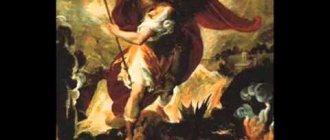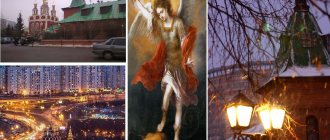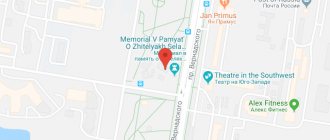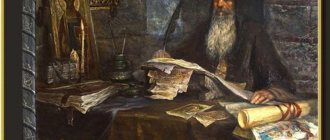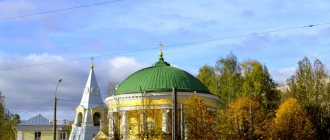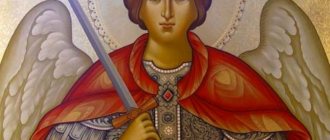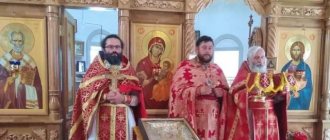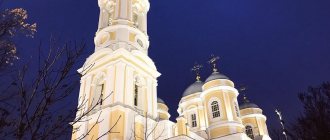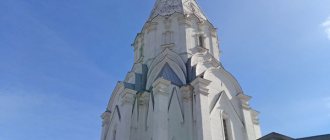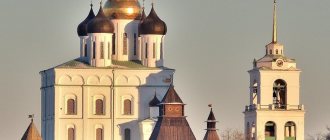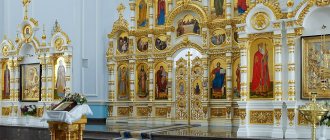Cathedral of the Archangel Michael and other ethereal Heavenly Powers celebrated annually November 21 (November 8, old style). This holiday is not one of the great and twelfth, but has always been revered in Rus'. Temples were built in his honor, and cities and villages were also named. The celebration of the Council of the Archangel Michael and other disembodied Heavenly powers was established at the beginning of the 4th century.
Cathedral of Archangel Michael and other ethereal Heavenly Powers. history of the holiday
From the books of the Old and New Testaments we learn about Angels - creatures of the invisible world, messengers of God. Numerous cases of their occurrence have been known to people for a long time. Already in apostolic times, a distorted, heretical opinion arose that one cannot pray directly to Christ, but must turn to the Angels. This heresy, according to Blessed Theodoret, even reached the level of idolatry.
Greatness is a song for the holiday. Pomeranian usage
At the beginning of the 4th century, at the local Council of Laodicea (several years before the First Ecumenical Council), the heretical opinion about angels as creators and rulers of the Universe was condemned. The Council approved the Orthodox veneration of the ethereal Heavenly Powers, and the holiday was established on November 8, on the eighth day of the ninth month - the year at that time began on March 1. This date was not chosen by chance. The eighth day symbolizes the future Council of all Heavenly Powers during the Last Judgment of God, which the holy fathers call the “eighth day,” when “the Son of Man will come in His Glory and all the holy Angels with Him” (Matthew 25:31). The ninth month of the year pointed to the nine ranks of angels. In the festive chant, magnification, the names of the ranks of angels are listed: “We magnify you, Archangels, Angels, Principalities, Powers, Thrones and Dominions, Powers and Cherubim, terrible Seraphim, glorifying the Lord.”
Library of the Russian Faith Teaching on the Council of the Archangel Michael. Great Menaion of Cheti →
Read online in original
Archangel Michael - Chief of the Highest Powers
The name Michael in Hebrew means “who is like God.” Archangel Michael, according to Orthodox teaching, is the Chief of all ethereal Heavenly Forces . He is called the archangel (Greek: αρχιστρατηγός - commander-in-chief) and acts as the head of the holy army of angels guarding God's law. Following this tradition, in the Great Menaions, Metropolitan Macarius writes:
God set up the preservation of Michael the Archangel as a kind of all-powerful weapon against the power of the devil.” In this image, Michael is revered as the patron and ally of the “militant Church.”
According to the tradition of the Church, reflected in the texts of the festive service, Archangel Michael appeared to people many times back in the days of the Old Testament - when the Israelites left Egypt and crossed the Red Sea. He appeared to Joshua and conveyed to him God’s command to take Jericho. Many other cases of the victorious help of Archangel Michael are described in church books.
“The Appearance of Michael to Jesus Navvinus”, miniature from the “Menologies of Basil II”
The names of other Archangels are also known from Holy Scripture and Tradition - apparently, those who carry a special mission in establishing the Kingdom of God on earth:
Archangel Gabriel is the evangelist of the mysteries of God; Archangel Raphael - physician of diseases and guide; Archangel Uriel - enlightens people, encourages them to pray; Archangel Jehudiel is an intercessor on the way, a helper to those in need of something for the glory of God; Archangel Barachiel is the giver of God's graces and guardian of the purity of soul and body; Archangel Salafiel is a doctor for malaria and a prayer book to God for people; Archangel Gefael is the igniter of love for God; Archangel Tachiel is a helper and protector in troubles and misfortunes.
Library of the Russian Faith Canon to St. Archangel Michael →
Read online
Troparion, tone 4.
Heavenly armies of the Archangel, we pray to you now that we are unworthy. For with your prayers you have covered us with shelter for the krill, your immaterial glory. Preserving us who pray diligently and cry out, deliver us from troubles, like an official to the highest powers.
Kontakion, tone 2.
Archangel of God, and servant of divine glory. A leader as an angel, and a mentor as a man. Ask for great mercy if there is any benefit for us, like the disembodied Archangel.
Prayer before the icon
Since the shrine patronizes military personnel, in the homes of their families the icon of the Archangel Michael is venerated at any hour, and not twice a year. In general, there are no restrictions or set time frames in prayers when one could ask for protection or deliverance from doubts and temptations.
Holy and great Archangel of God Michael, the inscrutable and all-essential Trinity, the first primate of the Angels, the guardian and guardian of the human race, crushing with his army the head of the proud Denis in heaven and putting to shame his malice and deceit on earth! We resort to you with faith and we pray to you with love: be an indestructible shield and a strong shield for the Holy Church and our Orthodox Fatherland, protecting them with your lightning sword from all enemies, visible and invisible. Do not, O Archangel of God, forsake us through your help and intercession, who today glorify your holy name: behold, even though we are many sinners, we do not want to perish in our iniquities, but to turn to the Lord and be quickened by Him to do good deeds . Illuminate our minds with the light of God’s face, which shines on your lightning-like brow, so that we can understand that God’s will for us is good and perfect, and that we know all that it is fitting for us to do and that which we should despise and abandon. Strengthen our weak will and weak will with the grace of the Lord, so that, having established ourselves in the law of the Lord, we will cease to be dominated by earthly thoughts and the lusts of the flesh, carried away in the likeness of senseless children by the soon-to-perish beauties of this world, as if for the sake of the corruptible and earthly it is foolish to forget the eternal and heavenly. For all of these, ask us from above for the spirit of true repentance, unfeigned sadness for God and contrition for our sins, so that we may spend the remaining number of days of our temporary life not in pleasing our feelings and working with our passions, but in erasing the evils we have committed with tears of faith and contrition of heart, deeds of purity and holy deeds of mercy. When the hour of our end approaches, liberation from the bonds of this mortal body, do not leave us. Archangel of God, defenseless against the spirits of wickedness in heaven, accustomed to block the souls of mankind from rising to heaven, yes, protected by you, we will reach those glorious villages of paradise without stumbling, where there is no sorrow, no sighing, but endless life, and, being honored to see the bright face of the All-Blessed Lord and Master ours, falling with tears at His feet, let us exclaim in joy and tenderness: glory to Thee, our dearest Redeemer, Who for Thy great love for us, unworthy, was pleased to send Thy angels to serve our salvation! Amen.
( 4 ratings, average: 5.00 out of 5)
Temples in honor of the Archangel Michael
After the Baptism of Rus', the holiday of the Council of Ethereal Powers becomes known to our ancestors. Many churches and monasteries were dedicated to this holiday - St. Michael's Day . The first Archangel Cathedral was built in Kiev immediately after the adoption of Christianity, and a monastery was established there.
Subsequently, many cases of miraculous assistance of the Archangel in military affairs were known. The Volokolamsk Patericon contains a description of the miraculous salvation of Veliky Novgorod from the Tatar army:
Sometimes, by God's permission, it was a sin for our sake, the godless Agaryan king Batu captured and burned the Russian land and went to the New City and God and the Most Pure Mother of God covered it with the appearance of Michael the Archangel, who forbade him to go against it. He went to the Lithuanian cities and came to Kyiv and saw the great Archangel Michael written above the doors of the stone church and said to the prince with his finger: “Forbid me to go to Veliky Novgorod.
It is not surprising that in almost every Russian city there was a temple or chapel dedicated to the feast of the Council of the Archangel Michael and the Ethereal Powers. Perhaps the most famous is the Archangel Cathedral of the Moscow Kremlin , the tomb of the Moscow princes. The original wooden Archangel Cathedral was probably built in 1247-1248, during the reign of Mikhail Khorobrit, brother of Alexander Nevsky. Subsequently, it was rebuilt more than once, and the current cathedral building was built in 1505-1508.
Archangel Cathedral of the Moscow Kremlin
There was also the Chudov Monastery in the Kremlin. The main temple of the monastery was consecrated in honor of the miracle of Archangel Michael in Khoneh (celebrated September 6/19). In 1929-1930 the monastery was destroyed.
In the middle of the 14th century. a wooden temple appeared in the name of Archangel Michael in the city of Kolomna . At this time, in the wall of the wooden fortress of Kolomna, between the Marinkina and Faceted towers, there were already passages of the Mikhailovsky Gate, opposite which the Mikhailovskaya (or Arkhangelskaya) settlement was located. After the Time of Troubles, the temple fell into disrepair. In 1700, the stone Church of the Archangel Michael with the chapel of the Three Saints was built. The currently existing stone church of the Archangel Michael received its modern appearance by rebuilding parts of the previous stone church.
Temple in the name of Archangel Michael in Kolomna
It was believed that Archangel Michael is the patron saint of the Russian army. St. Michael the Archangel Cathedral in 1221 . Subsequently, it was rebuilt several times. The current cathedral building was built in 1628-1631. in memory of the Nizhny Novgorod militia.
Archangel Cathedral of the Nizhny Novgorod Kremlin
It is also worth mentioning that the banner of the Nizhny Novgorod militia depicts Archangel Michael in military armor and Jesus Navvinus bowing before him.
Banner of the Nizhny Novgorod militia that liberated Moscow in 1612
Beyond the Siversov Canal, a little south of Nereditsa, near Seltso-Shaterno, Novgorod region, there are the remains of the stone temple of the Archangel Michael in the Skovorodsky Monastery . The founder of the monastery and the builder of the stone temple was the Novgorod ruler Moses (1324-1329). The Church of the Archangel Michael was built by order of Archbishop Moses in 1355. In its architectural forms, the St. Michael's Church was close to the Volotovo church near Veliky Novgorod. The laconicly designed facades of the building, which did not even have blades, ended with a three-blade zakomara. The volumetric composition was complemented by porches from the north, west and south. Leaving the department in 1360, Archbishop Moses retired to the Skovorodsky Monastery, where he died and was buried on January 25, 1362. In the XVIII-XIX centuries. the temple was repaired several times, supplemented with extensions, received a new roof, and instead of the original one dome, it was crowned with five domes. The temple was practically destroyed during the Great Patriotic War.
Ruins of the St. Michael the Archangel Church of the Skovorodsky Monastery near Seltso-Shaterno, Novgorod region
A temple in Veliky Novgorod was consecrated in the name of Archangel Michael . The wooden church of the Archangel Michael in Torg has been known since the 12th century. Later the church was built in stone. The church was rebuilt in the 14th-15th centuries, and the northern gallery was erected in the 16th century. By the beginning of the 19th century, the Church of the Archangel Michael was a ruin. In the second half of the 19th century, the upper part of the building was restored with new materials in the architectural forms of the time. In the lower part, foundations and wall masonry from the 14th-15th centuries have been preserved.
Temple in the name of the Archangel Michael in Veliky Novgorod
In the name of the Archangel Michael, a temple was consecrated in the village of Kobylye Gorodishche, Gdov district, Novgorod region . The temple was built in the 15th century. The thick walls of the temple are made of slabs. A “tribune” or lantern rises above the building, surrounded at the top by several rows of scars and squares; they are terminated by a series of concentric semicircular depressions. On the lantern there is a pear-shaped head, initially covered with wood chips and later with iron. Two pillars separate the altar from the church, and two are connected by an arch to the walls. Above the arches there are windows, some span, and some solid. The altar is separated from the altar and sacristy by walls with narrow spans. Currently, the Church of the Archangel Michael is an active temple of the Russian Orthodox Church.
Temple in the name of the Archangel Michael in the village of Kobylye Gorodishche, Gdov district, Novgorod region
The cathedral in Ryazan was consecrated in the name of Archangel Michael . The first mention of the Archangel Cathedral dates back to the end of the 15th century. Since 1756, it was noted in the scribe books that the cathedral church had fallen into such disrepair that it was no longer possible to serve in it. For many years, services in the cathedral ceased, but through the efforts of Archbishop Sergius, repair work began in the Archangel Cathedral. In 1819, the temple was completely ready to once again receive parishioners. During Soviet times, the cathedral, like many churches in Russia, was closed. His property was requisitioned. The interior was gradually destroyed. Nowadays, the cathedral houses an exposition of the Ryazan Kremlin Museum.
Temple in the name of the Archangel Michael in Ryazan
In the name of Archangel Michael, a temple was consecrated in the city of Slobodskaya, Kirov region . The church was built in 1610. It is known that the design of the roof was such that it did not allow the penetration of moisture and rotting of wooden parts, and the building itself was built with the expectation of natural ventilation of the walls. It was part of the complex of the Epiphany, later Holy Cross Monastery, founded in 1599 on the outskirts of the city. At first, this building served not only as a church, but also as a fortress tower with a gate through which one could enter the monastery, and through loopholes in the walls one could shoot back from the enemy. The small wooden church was inconspicuous compared to the buildings of the monastery and did not attract attention. Nowadays, a unique collection of wooden temple figures is exhibited in the Archangel Michael Church - the only one in the Kirov region.
Michael the Archangel Church in Slobodskaya, Kirov Region
In the name of the Archangel Michael, a temple was consecrated in the village of Andreevshchina, Lodeynopolsky district, Leningrad region . The temple was built in 1613. Description of St. Michael's Church given in the News of the Imperial Archaeological Commission: “In 1848, a foundation of wild stone was laid under the church, and its walls were lined with planks. Height 11, length 9 1/3, width 2? soot The windows are small, square, three lights. The ceiling is covered with a Christmas tree. There is no salt. The iconostasis is old, in chapels, in 4 tiers, with old icons. The revealed icon of St. St. Nicholas the Wonderworker, found in the ground near the place where the landowner Andrei Zavalishin lived, monastically the Venerable Andrian Andrusovsky, whose relics rest in the Andrusov Hermitage. Birch bark wedding crowns are kept in the church. The church has given a significant slope on the western side. In 1913, its renovation was allowed.” The church is currently lost.
A temple in the name of the Archangel Michael was consecrated in the village of Andreevshchina, Lodeynopolsky district, Leningrad region
, the cathedral on the Mikulin settlement in the Lotoshinsky district of the Moscow region was consecrated . The cathedral was built in the late 1550s. in the center of the ancient settlement of the Tver princes, surrounded by earthen ramparts about 5.5 meters high and 600 meters in circumference. The fortress, well fortified and surrounded by high ramparts with a fortress (a wall of logs), served as an outpost of the Tver Principality during its rivalry with Moscow. An older cathedral built in 1398 stood on the site of the current one. The present temple was originally built as the tomb of Prince S.N. Mikulinsky, who inherited the estate from his ancestors, appanage princes. A basement was made under the cathedral, in which the tomb was located. When the cathedral needed to be strengthened at the end of the 18th century, the crypt was filled up. The huge four-pillar temple was originally five-domed, with a roof covering, it was built of half-rubble brick, that is, the outer and inner parts of the wall were lined with brick, and the space between them was filled with broken stone and filled with mortar. The facades of the cathedral are divided by blades into three parts (spreads), ending in wide zakomaras. In the middle of the three facades there are huge perspective portals, which from a distance seem like very small doors. In 1886-1887 The ancient building has undergone another restoration. During Soviet times, the temple remained closed since 1922. Currently, the temple belongs to the Russian Orthodox Church, and weekly services are held there.
Cathedral in the name of the Archangel Michael on the Mikulin settlement in the Lotoshinsky district of the Moscow region
In the name of Archangel Michael, a temple was consecrated in the village of Synkovichi, Grodno region of the Republic of Belarus . The date of construction of the temple is considered to be 1407. The architecture of the temple clearly shows features characteristic of the Gothic style, as well as details of ancient Russian architecture. It is known that in 1880-1892. The temple was reconstructed - the roof was replaced, a vestibule and a dome were built over the apse, the dome over the central part of the temple was dismantled, and a rubble-brick two-tier tetrahedral bell tower was erected. After World War II the church was closed. The activity of the temple was resumed in 1992.
Michael the Archangel Church in the village of Synkovichi, Grodno region of Belarus
In the name of the Archangel Michael, a church was consecrated in the village. Chesniki, Ivano-Frankivsk region of Ukraine . The stone church is built of limestone, three-faced, with a rectangular nave and baba and a faceted five-walled eastern volume. The church is covered with three domes without drums. The finished roof over the nave has the appearance of a square top with two creases; the side rooms are covered with a plastic pitched shingle roof. The smooth planes of the walls are devoid of decoration and are enlivened only by low entrance openings on the western and southern facades with small windows above them. In the 19th century, the northern and southern facades were strengthened with powerful buttresses.
Temple in the name of the Archangel Michael in the village. Chesniki Ivano-Frankivsk region of Ukraine
In the name of Archangel Michael, a church was consecrated in the city of Svalyava, Transcarpathian region of Ukraine . The church dates from 1588. The church acquired its modern appearance during a major reconstruction in 1759. The wooden church was built from oak beams. The walls of the tower are covered with shingles, the roofs and walls are covered with ploughshares. Consists of three different-wide log houses. Each log house is covered with a separate roof, but they are perceived as fused together thanks to the soft transition of the nave floor into the roof of the eastern part and the common roof of the porch and babinets, which accentuates the entrance. The submission is based on the release of the crowns of the log houses. The roofs of the eastern part and the nave are topped with small square turrets with onion-shaped domes with hipped aprons. Under the roof of the nave, one hall of the log house has been preserved, the second has been converted into a box vault. The church was restored in 1972.
Temple in the name of the Archangel Michael in the city of Svalyava, Transcarpathian region of Ukraine
In the name of Archangel Michael, a church was consecrated in the city of Oster, Chernigov region of Ukraine . The church was built in 1098 by Vladimir Monomakh, possibly as the church of the princely castle “Gorodok na Vostra”. It was probably part of the castle's earthen-wooden fortification system. In 1195, the son of Yuri Dolgoruky, Vsevolod Yuryevich, restored the Church of St. Michael the Archangel. In 1753, the wooden top was burned by lightning, and the masonry began to collapse as a result of the hill shifting towards the river. But no money was found for major repairs, and the temple continued to deteriorate. At the end of the 18th - beginning of the 19th centuries. the ruins of the church were dismantled, leaving the apse and part of the south-eastern wall. It was only in 1907 that the first conservation of the remains was made. Only a semicircular apse has survived to this day, the inner radius of which is about 3 meters, and a small part of the wall on the south side.
Temple in the name of the Archangel Michael in the city of Oster, Chernihiv region of Ukraine
The Vydubitsky Monastery in Kiev was consecrated in the name of Archangel Michael . The monastery was founded around 1070 by Vsevolod Yaroslavich in the Vydubychi tract, near the Dnieper crossing and his personal castle residence - the Red Court. The main temple of the monastery was the Church of the Archangel Michael. To save the monastery church from landslides, a grandiose retaining wall was built in 1199. After the Union of Brest, the monastery passed into the hands of the Uniates from the Basilian Order. The old monastery cathedral of the Miracle of the Archangel Michael in Khoneh collapsed into the Dnieper in the middle of the 16th century. In 1555 it was rebuilt by Abbot Klimenty Starusich. In 1637, the Church of St. Michael the Archangel was restored. The monastery was liquidated in 1924. The churches were still active until the 1930s, when their iconostases were burned and the cemetery was destroyed. The buildings of the former monastery were handed over to the workers and employees of the woodworking plant on Telichka. In 1967-1982. restoration of the buildings was carried out. In 1975-1997 The Institute of Archeology was located here. The monastery resumed its activities in 1992. In 1996, the government completely returned the Vydubitsky Monastery to the Church (UOC-KP).
Temple in the name of the Archangel Michael of the Vydubitsky monastery of the same name in Kyiv
Architectural features of the Archangel Cathedral
The Italian architect built the cathedral, 21 meters high, of white stone in the traditional ancient Russian style - a five-domed cross-domed church with narrow slit-like windows.
The cathedral is crowned with five domes on drums of different diameters, arranged asymmetrically, which creates the impression of the airy lightness of the temple and upward direction. The main entrance is in a wide recess. Italian and Byzantine architectural traditions are intertwined in the six-pillar, five-sided structure with 8 side chapels.
Exterior of the temple
The appearance of the cathedral is special, this is achieved by decorative forms of decoration. The architect divided the facade of the cathedral into two tiers with a horizontal cornice. Each tier looks like a complete, independent floor - the cathedral looks like it has two floors. The lower tier, high and powerful, with decorative arches, is a kind of pedestal for the lighter upper tier of smaller height, decorated with panels.
The vertical rectangular projections of the wall are also divided horizontally. The architect turned them into pilasters. Along the middle line of each tier there are tall narrow windows. The architectural decoration of the temple includes both rounded medallion windows and large arched windows, bringing the Russian cathedral closer to the Venetian palace.
The niches located along the perimeter of the upper part of the facade are traditionally Russian decorations, made in the form of sea shells with pearls, elegant and unusual for Russian architecture.
Along the vertical façade there are pilasters topped with intricate floral patterns with carved capitals. The huge double window of the facade with a group of small round windows looks solemn and strict. An amazing decoration of the cathedral is the carving that imbues the portals with white stone patterns. The decor of the rosettes and capitals is not repeated anywhere.
Temple interior
The lush, elegant and solemn decor of the facade is contrasted with the interior of the cathedral. The cylindrical vaults of the temple rest on cross pillars, traditional for Russian churches. The interior of the vaults is light and free; when you look up, you feel delight.
A solemn twilight mood arises when looking at the dark blue wall paintings and sarcophagi at the bottom of the cathedral, where twilight prevails.
Birthday city
In the 12th century, Archbishop John of Novgorod founded the St. Michael the Archangel Monastery at the mouth of the Northern Dvina. For a long time it was one of the centers of the Russian North.
View of the Archangel Michael Monastery from the pier, from the southeast side. Photograph from the 1880s by an unknown photographer
In 1548, by order of Tsar Ivan IV, governors Nashchokin and Zaleshanin built a fortress around the monastery in one summer. Initially it was called New Kholmogory. But already in 1596 the new city was named Arkhangelsk , after the monastery.
Rectors of the cathedral
- John (mentioned in 1439),
- John (mentioned in 1454-1463),
- Michael (mentioned in 1507),
- Judas (mentioned in 1518-1519),
- Simeon (mentioned in 1542-1550),
- Timofey Yakovlev (mentioned in 1551),
- Eustathius (mentioned in 1564-1565),
- Grigory Ivanov (mentioned in 1569-1570),
- John (executed by order of John IV on November 27, 1575),
- Vasily (mentioned in 1584-1585), Gregory (mentioned in 1593),
- Demetrius (mentioned in 1599-1608),
- John (mentioned in 1613-1630),
- Gregory (mentioned in 1634-1643),
- Nikifor Matveev (mentioned 1645 - ca. 1657),
- Kodrat (mentioned in 1658-1672),
- Theodore (mentioned in 1675-1691),
- Peter Vasiliev, confessor of Peter I (mentioned in 1696-1703),
- Iakov Mikhailov (appointed in 1723, mentioned before 1734),
- Ioann Semenov (c. 1738 - 1741) [1],
- Vasily Ivanov, former confessor of Empress Anna Ioannovna (appointed in 1741, mentioned before 1745)
- John Komarovsky (mentioned in 1749 - 1771),
- Peter Alekseev (1771-1801),
- Dimitry Lavrovsky (1801-1811),
- Alexy Shumilin (1811-1813),
- Jacob Nikolsky (1813-1816),
- Gerasim Popov (1816-1818),
- John Rusinov (1818),
- Vasily Kutnevich (1818-1833),
- Arseny Tyazhelov (1833-1855),
- Pyotr Pokrovsky (1855-1871),
- Mikhail Bogoslovsky (1871-1880),
- Alexander Nevsky (1888-1892),
- Valentin Amfitheatrov (1892-1901),
- Pavel Izvekov (1905-1909),
- Dimitry Lavrov (1910-1914),
- Nikolay Izvekov (1915-1918)
Old Believer churches in honor of the Archangel Michael
The tradition of celebrating “Michael’s Day” was also preserved by the Old Believers. In all Old Believer communities there are churches consecrated in the name of this holiday.
Today is the patronal holiday in the communities of the Russian Orthodox Old Believer Church in Voronezh, village. Putino, Perm region, village. Kilmez, Kirov region, st. Manychskaya, Rostov region, village. Malinovka, Tomsk region, as well as churches under construction in the city of Glazov (Udmurtia) and the city of Zlynka (Bryansk region). In foreign communities of the Russian Orthodox Church, a temple holiday in the communities of Balti (Moldova) and the village. Valaya Rodoia, Floresti district (Moldova).
Church of the Russian Orthodox Church in the name of Archangel Michael, Putino village, Perm Territory
Temple of the Archangel Michael. Balti
The patronal holiday is celebrated in the communities of the Russian Ancient Orthodox Church in Volgograd and the village. Ursk, Kemerovo region.
Church of the Russian Children's Center in the name of Archangel Michael, Volgograd
Pomeranian communities of Nevel and village. Mikhalkino in the Pskov region, Kuznetsk in the Penza region, Temir-Tau in the Kemerovo region, and the Utena community (Lithuania) also celebrate their patronal holiday today.
Temple of the Archangel Michael. Utena
Cathedral of the Archangel Michael. Icons
Archangel Michael is often depicted as part of the so-called “angelic deesis”.
Archangel Michael. From the Deesis rank. Tver, first half of the 15th century. Tretyakov Gallery
Archangel Michael is often depicted with a cane-spear in one hand and a special sphere-mirror (a symbol of foresight transmitted to the Archangel by God) in the other.
“Archangel Michael” from the Zvenigorod Deesis rite. Beginning 15th century. Andrey Rublev. Tretyakov Gallery
"Archangel Michael" ca. 1300, Yaroslavl
On later icons, Archangel Michael can be depicted trampling the devil with his feet, in his left hand, as a winner, holding a green date branch, in his right hand - a spear with a white banner, on which a scarlet cross is inscribed (symbolizing the victory of the Life-giving Cross over the devil) or holding a flaming sword and shield. Michael can also be presented as the guard of the Heavenly King, dressed in military armor, or riding a horse.
Archangel Michael trampling on the devil. 17th century Tretyakov Gallery, Moscow
Icon of Archangel Michael with deeds. 1410s. Archangel Cathedral of the Moscow Kremlin, Moscow
Among the icons dedicated to the Archangel Michael, one can see “The Appearance of the Archangel Michael to Joshua” and “The Cathedral of the Archangel Michael.”
Icon of the Cathedral of the Archangel Michael. Early 19th century
Icon of the Miracle of the Archangel Michael in Khoneh. From the Cathedral of St. Sofia in Veliky Novgorod. 1484–1504
